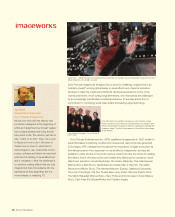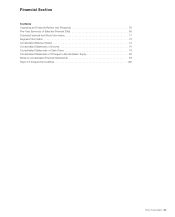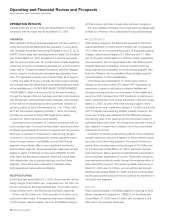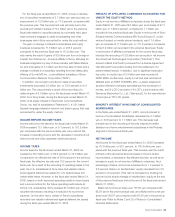Sony 2005 Annual Report Download - page 34
Download and view the complete annual report
Please find page 34 of the 2005 Sony annual report below. You can navigate through the pages in the report by either clicking on the pages listed below, or by using the keyword search tool below to find specific information within the annual report.
Sony Corporation 31
Cinema’s Digital Revolution
The CineAlta professional movie production system, a high-definition video format
(HDCAM 24P), has introduced a revolutionary new movie production process that
employs digital technologies while recording on tape to achieve the realism of
film imaging.
CineAlta, which takes its name from “cinema” and “alta,” the Spanish word for high,
uses the same frame rate, 24 frames per second, as conventional movie films and
achieves the same color and texture quality. The CineAlta project team, formed in
1998, succeeded in commercializing CineAlta in merely one and a half years.
The CineAlta system was used to shoot the entire 2002 blockbuster Star Wars
Episode II: Attack of the Clones, as well as 2005’s sequel Star Wars Episode III:
Revenge of the Sith. The more recent film used the upgraded CineAlta RGB444
system, which has RGB color reproduction capabilities that deliver even greater
realism.
Sony Electronics Inc. and Panavision Inc. jointly
received a 2004 Primetime Emmy Engineering
Award from the Academy of Television Arts &
Sciences for the Panavised F900 HD 1080/24P
CineAlta camcorder. The Panavised F900 has
become the new standard for documentary and
independent moviemakers as the world’s first digital
24P imaging system. It incorporates high-quality
optics and cutting-edge digital processing and
recording technologies in a single package.
Sony’s 4K SXRD projector heralds new
advances in digital cinema.
At Sony, we were not content to stop at modern-
izing film production. We pressed on with the development of digital cinema, in which
movies are both recorded and projected digitally. In 2005, we successfully commer-
cialized and launched the industry’s first “4K” digital projector. The 4K projector is a
digital cinema projector incorporating a 4K Silicon X-tal (“crystal”) Reflective Display
(SXRD) device, which produces high-resolution 8.85-megapixel images, four times
sharper than those of current high-definition televisions.
With the advent of our digital projector, movies can be presented in theaters with
virtually no degradation in quality from when they are recorded. Quality does not
diminish with repeated use, leading to significant time and cost savings.
Sony Corporation 31
Rick McCallum
Producer, Lucasfilm Ltd.
Let me be blunt. We simply could not
have made Star Wars Episode III without
the help of Sony and their development
of the HDCAM-SR 4:4:4 camera and
recording system.
Since we have gone to a completely
digital pipeline, another world has
opened up to us.
George Lucas and I are very passion-
ate about digital filmmaking, and all of us
at Lucasfilm appreciate the contribution
CineAlta has made to our work. The two
main ways it has impacted our work has
been in allowing us to be more creative
and increasing our workflow efficiency.
For example, we can instantly access
footage we have just shot, which helps
not only the director, but the cast as well.
This, coupled with longer recording
times, helps us keep the production
moving at a fast pace without losing
momentum for camera reloads. Addi-
tionally, digital shooting allows us to go
into post production, not only off-line but
even online without any chemical pro-
cesses like telecine, film scanning and
color timing, which increases our
production efficiency dramatically.
I believe that digital acquisition gives
us a significant advantage. It really is a
shame that very few people can enjoy
our movies in theaters at the same
quality level in which we shoot them.
Someday when the entire process
is digital, including the elusive final link of
theatrical distribution, moviegoers will get
to see films the way they were meant to
be seen. That will be a great day, and
one that Sony will have made a major
contribution to.
Director George Lucas on the set of
Star Wars Episode II: Attack of the Clones
James Cameron, renowned director of
Titanic, shot the 3-D feature Ghosts of the
Abyss using a CineAlta system in a special
housing. Diving 3,650 meters in a deep-sea
submersible to explore the Titanic, Cameron’s
crew penetrated the interior of the sunken
liner to capture scenes never before
witnessed by the living.
A still from the film Ghosts of the Abyss directed by James Cameron and
used with the permission of Walden Media, LLC.
From left: Noritaka Miyaji and Kiyoshi
Yamauchi (Professional Solutions Network
Company, Sony Corporation) and Yasuhiko
Mikami (Sony Electronics Inc.) celebrate as
co-recipients of the 2004 Primetime Emmy
Engineering Award.
S ONY AR -E 0629 Adobe PageMaker 6.0J /PPC
























